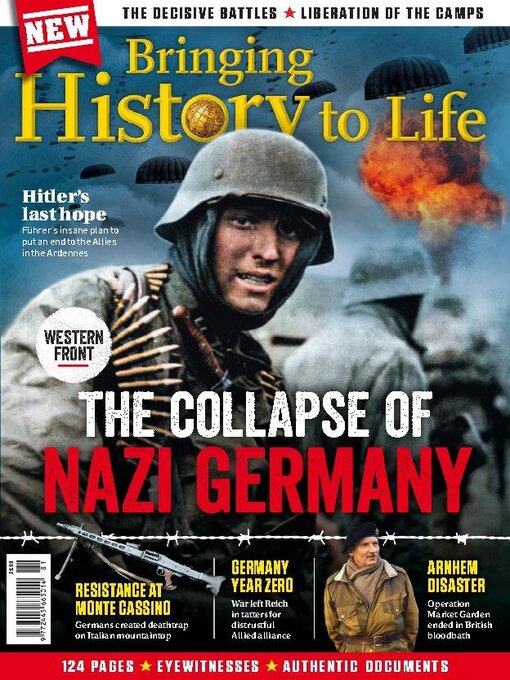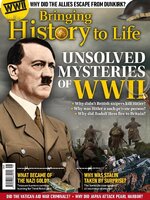In 1933, Adolf Hitler seizes power in Germany, where he has seduced the population with golden promises of a restoration of the Great German Empire. He allies himself with Mussolini's fascist Italy, Stalin's communist Soviet Union and the military dictatorship in Japan, which has the same dreams of grandeur as Germany. In this series, you get a thorough review of World War II - from the birth of fascism through the war's many dramas to the aftermath, where the victors deal with the war's worst criminals.
WELCOME
THE BATTLE OF MONTE CASSINO • The Allies had driven Hitler's troops out of Africa and Mussolini's fascist regime had collapsed. The joy of victory was spreading, but the advance through Italy stalled 130 kilometres from Rome. Based in a medieval monastery at the top of Monte Cassino, the Germans had blocked the route the Allied forces had to take.
BRIDGE OF DEATH IN ARNHEM • Nazi Germany was faltering and in September 1944, British Field Marshal Montgomery intended to deliver the death blow; 20,000 paratroopers would capture Dutch bridges so Allied tanks could cross the Rhine and continue into Germany. But Hitler’s army was far from exhausted and the British were heading for a bloodbath.
HUNGRY HOLLAND • In September 1944, the Dutch government in exile was convinced that it wouldn’t be long before the Allies kicked the Germans out of the country. They therefore ordered a railway strike to paralyse German troop transports to the front. But liberation never came, and the Dutch soon felt the Nazis’ revenge.
Dutch had to be starved into submission • As Operation Market Garden got underway, Dutch railway workers threw everything they had into helping the Allies. The effects of the Hunger Winter, when the Germans tried to starve the Dutch population into submission as a consequence of the strikes, can still be seen.
HITLER’S LAST HOPE • Allied troops finally reached the borders of Nazi Germany in late 1944. Soldiers and generals alike anticipated a quick death blow, which would allow them to finally return home. But Hitler had other plans. He wanted to teach his enemies a lesson using the same blitzkrieg strategy that had overwhelmed France in 1940.
THE ALLIES CROSS THE RHINE • In March 1945, the Allies prepared to cross the River Rhine, a liquid line of defence that wound along Germany’s western border. Guns, tanks and hundreds of thousands of soldiers were deployed in an attempt to remove the last German defences and advance deep into the heart of Nazi Germany.
ALLIES LIBERATE THE CAMPS • In April 1945, Allied reconnaissance units discovered fenced-off camps across Germany. To the soldiers’ horror, starving prisoners staggered out from behind the barbed wire, and six years after the outbreak of war, the full extent of the Nazis’ atrocities was finally revealed to soldiers, journalists and the wider world.
“I couldn’t have lasted another day” • Jack Adler was just ten when the Nazis invaded Poland. For the next six years, he experienced the Holocaust first-hand in the Polish ghettos, Auschwitz and finally Dachau. His entire family was murdered and Adler himself barely survived – thanks to the rare help of an SS officer.
GERMANY, YEAR ZERO • Nazi Germany no longer existed. The Reich had been divided into four, and left without a government, police or fire brigade, while its citizens lacked food, clothing and shelter in conditions worse than when Hitler rose to power. A fragile international alliance had to rebuild the country and reveal a path away from Nazism.
EUROPE – May 1945
PICTURE INDEX
READING LIST
Bringing History to Life

 Panzer!
Panzer!
 Unsolved Mysteries of WWII
Unsolved Mysteries of WWII
 Fall of Berlin
Fall of Berlin
 Battle of Stalingrad
Battle of Stalingrad
 Special Forces - Equipment! Tactics! Missions!
Special Forces - Equipment! Tactics! Missions!
 The Collapse of Nazi Germany / Western Front
The Collapse of Nazi Germany / Western Front
 Operation Barbarossa
Operation Barbarossa
 Nazi Stormtroopers
Nazi Stormtroopers
 World War II - Key events 1939-1945
World War II - Key events 1939-1945
